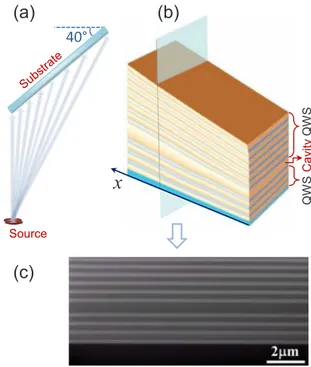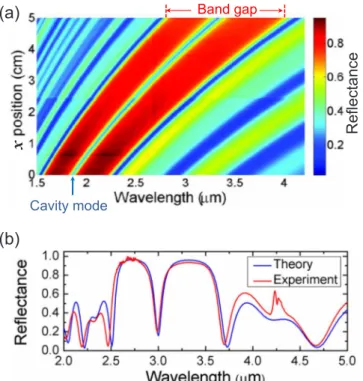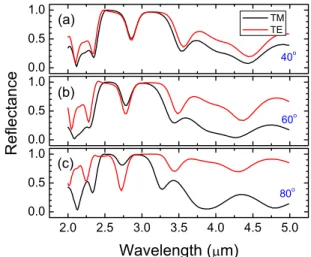All-chalcogenide glass omnidirectional photonic band gap variable infrared filters
H. Esat Kondakci, Mecit Yaman, Ozlem Koylu, Aykutlu Dana, and Mehmet Bayindir
Citation: Appl. Phys. Lett. 94, 111110 (2009); View online: https://doi.org/10.1063/1.3103279
View Table of Contents: http://aip.scitation.org/toc/apl/94/11 Published by the American Institute of Physics
All-chalcogenide glass omnidirectional photonic band gap variable
infrared filters
H. Esat Kondakci,1,2,a兲 Mecit Yaman,1 Ozlem Koylu,1 Aykutlu Dana,1 and Mehmet Bayindir1,2,b兲
1
UNAM-Institute of Materials Science and Nanotechnology, Bilkent University, 06800 Ankara, Turkey
2
Department of Physics, Bilkent University, 06800 Ankara, Turkey
共Received 10 January 2009; accepted 26 February 2009; published online 18 March 2009兲 We report on the design, fabrication, and characterization of spatially variable infrared photonic band gap filter that consists of thermally evaporated, high refractive index contrast, amorphous chalcogenide glass multilayers. Due to graded thickness structure, the filter exhibits a position dependent stop band and a cavity mode ranging from 1.8 to 3.4 m wavelengths. Reflection measurements on the variable filter agree well with theoretical calculations. These results pave the way to low-loss infrared mirrors, filters, spectral imaging, and miniaturized spectrometers at infrared region. © 2009 American Institute of Physics.关DOI:10.1063/1.3103279兴
Dielectric mirrors are simple one-dimensional photonic structures made using quarter wave stacks 共QWSs兲.1 It was recently shown that QWS fabricated with high contrast index materials may posses full photonic band gaps resulting in omnidirectional reflection,2,3which opens up the possibility of making infrared 共IR兲 mirrors4 and filters5–7 at specific wavelengths by choosing suitable dielectric materials and by controlling layer thicknesses. Such optical components are critical in designing spectrometers, military applications, and chemical and biological sensors at the IR region.8
The QWS structures can be obtained by chemical vapor deposition,9 sol-gel processing,10 molecular beam epitaxy,11 spin coating/thermal evaporation,3 or thermal evaporation.12 In addition to the above-mentioned techniques the amor-phous chalcogenide glasses can be thermally evaporated on the large area polymer films.13In this case the radial QWSs are obtained by rolling the coated polymer film on a cylin-dirical rod. Subsequently, the macroscopic structures are drawn into various photonic band gap fibers at visible5,6and IR wavelengths.4Although the radial polymer/chalcogenide multilayers form otherwise a perfect omnidirectional mirror, which guides light through the hollow core of the transmis-sion fibers, the strong absorption of polymer layers at IR region limits reducing the transmission loss further.
Since chalcogenide glasses have unique properties such as high refractive indices and transparency at IR region, they are excellent materials to be used in omnidirectional photonic applications.6,14,15 For example, by using all-chalcogenide photonic band gap structures one can reduce the transmission losses in hollow-core fibers. Moreover, om-nidirectional mirrors and filters can be used in order to de-sign miniaturized IR spectrometers.
In this work, we present an omnidirectional QWS con-sisting of high refractive index contrast chalcogenide glasses that are thermally evaporated on a substrate consecutively. A spatially variable IR Fabry–Pérot filter is designed and fab-ricated by thermal evaporation on a tilted silicon substrate, as shown in Figs.1共a兲and1共b兲. The filter consists of alternating low-index As2S3 and high-index Ge15As25Se15Te45 共GAST兲
stacks with an As2S3cavity layer关Fig.1共c兲兴. The utilization of high-index contrast chalcogenide glasses in a slanted ge-ometry results in a position dependent full photonic band gap and cavity mode. The structures are simulated by using the generalized transfer matrix method for coherent and incoher-ent multilayer structures with finite substrates.16We observed that the cavity wavelength shifts from 1.8 to 3.4 m on a 5 cm long substrate.
The high-index chalcogenide GAST glass was synthe-sized from high-purity 共5–6N兲 Ge, As, Se, and Te elements 共Alfa Aesar兲 using conventional sealed-ampoule melt-quenching techniques.17,18For the low-index material, As2S3 共Amorphous Materials兲 was chosen due to thermal compat-ibility with GAST glass. To characterize optical properties of As2S3 and GAST thin films, bulk glasses were deposited on
a兲Electronic mail: kondakci@bilkent.edu.tr.
b兲Electronic mail: bayindir@nano.org.tr. URL: http://bg.bilkent.edu.tr.
(a)
(c)
QW Sx
Cav ity QW S 40°(b)
SourceFIG. 1. 共Color online兲 Schematic representation of 共a兲 slanted evaporation geometry and 共b兲 spatially variable multilayer filter structure. 共c兲 Cross-sectional scanning electron micrograph of the 20 layer As2S3– Ge15As25Se15Te45multilayer structure. The dark layers correspond to As2S3layers with a/2n cavity layer.
APPLIED PHYSICS LETTERS 94, 111110共2009兲
silicon substrates by thermal evaporation 共Vaksis Elif, pres-sure of ⬃10−6 Torr, deposition rate of ⬃100 Å/s兲. Subse-quently, the films were annealed for 2 h near the glass tran-sition temperature 190 ° C in a vacuum oven.
The refractive index n and the extinction coefficient k of the deposited films are obtained in the visible and mid-IR region from spectroscopic ellipsometry measurements共J. A. Woollam VASE, IR-VASE兲.19
As shown in Fig.2, both chal-cogenide glasses are transparent between 1.5 and 25 m. At 3 m, GAST and As2S3has a high-index ratio of 3.22:2.33, which is required for achieving an omnidirectional photonic band gap.
The IR filter consists of alternating layers of low-index 共As2S3兲 and high-index 共GAST兲 glasses on a silicon sub-strate. In accordance with the simulation results, ten pairs of alternating As2S3and GAST layers are thermally evaporated with thicknesses, 322 and 233 nm, respectively, to produce a photonic stop band centered at 3 m关Fig.1共c兲兴. The As2S3 cavity layer is located at the 13th layer from the top with a thickness of 644 nm. The graded thickness profile is obtained by simply giving a slant to the substrate with respect to the horizontal during thermal deposition关Fig.1共a兲兴. In our case, a 40° slant gives a thickness profile for As2S3共GAST兲 layer from 193 nm共140兲 to 365 nm 共264兲 along the 5 cm substrate. In order to determine the position dependence of the cavity mode, Fourier transform IR共FTIR兲 spectroscopy mea-surements in reflection mode are made along the substrate 共Bruker FTIR Vertex 70 with Hyperion microscope兲. As shown in Fig. 3共a兲, the cavity mode shifts from 1.8 to 3.4 m from one edge 共x=0兲 of the substrate to the other 共x=5 cm兲. Note that position dependence of the cavity mode is not exactly linear due to the thermal evaporation geometry. The calculated reflection spectrum for the filter position hav-ing the band gap centered around 3 m agrees well with the measured results 关Fig.3共b兲兴.
Furthermore, the reflectance spectra of the filter are in-vestigated for oblique angles by performing simulations for the filter position having the cavity mode centered at 3 m. Using the generalized transfer matrix method, the reflectance spectra are determined for all incidence angles and both TE/TM polarizations. Figure 4 shows the calculated
reflec-Reflectance Cavity mode Band gap
(a)
(b)
x
FIG. 3. 共Color online兲 共a兲 Position dependent reflectance measurements taken from 80 linearly spaced positions along the sample.共b兲 Comparison of theoretical and experimental reflectance spectra taken at a position 4 cm away from the short-wavelength side of the filter. Both the simulation and FTIR measurements are performed at normal incidence.
FIG. 2. 共Color online兲 Measured index of refraction and extinction coeffi-cient of共a兲 thermally evaporated As2S3and共b兲 Ge15As25Se15Te45thin films. The refractive index contrast allows to achieve omnidirectional photonic band gap.
Omnidirectional band gap
TM
TE
Reflectance
FIG. 4. 共Color online兲 Calculated reflectance spectra of the omnidirectional filter as a function of wavelength for TM and TE polarizations for all angles of incidence at a position having the band gap centered around 3 m.
tion spectra for incidence angles ranging from 0° to 90°. While the omnidirectional band gap extends from 2.6 to 3.3 m, the cavity mode shifts to lower wavelengths as in-cidence angle increases. The omnidirectional reflections are also confirmed by the ellipsometric measurements at various incidence angles. Reflection spectra at three oblique angles are shown in Fig.5for all polarizations. The cavity mode is more sensitive to higher incidence angles to TM polarization. The reflection spectra shown in Fig.4 demonstrate that the peak wavelength of the cavity mode in the stop band is rather insensitive to angles of incidence. This makes the fab-ricated devices particularly suitable for IR spectral imaging and spectrometry. Using a hot filament as a source, even under poor collimation conditions, the filters effectively pass a narrow band of the IR radiation based on the spatial posi-tion. Applications of variable wavelength all-chalcogenide IR filters may potentially include portable 共miniaturized兲 IR spectrometers, disposable chemical, and biological sensors. In addition, thermomechanical compatibility of such glasses enables thermal drawing of low-loss photonic band gap transmission4 and externally reflecting fibers,13 and on-fiber optoelectronic devices5 at IR region. It is also possible to fabricate hollow-core omnidirectional on-chip waveguide
structures for photonic applications at near- and mid-IR wavelengths.20
This work is supported by TUBITAK under the Contract Nos. 106T348, 106G090, and 107T547. M.B. acknowledges support from the Turkish Academy of Sciences Distin-guished Young Scientist Award 共TUBA GEBIP兲. This work was performed at the UNAM-Institute of Materials Science and Nanotechnology which is supported by State Planning Organization of Turkey through the National Nanotechnol-ogy Research Center Project.
1P. Yeh, A. Yariv, and C.-S. Hong,J. Opt. Soc. Am. 67, 423共1977兲. 2J. N. Winn, Y. Fink, S. Fan, and J. D. Joannopoulos,Opt. Lett. 23, 1573
共1998兲.
3Y. Fink, J. N. Winn, S. H. Fan, C. P. Chen, J. Michel, J. D. Joannopoulos, and E. L. Thomas,Science 282, 1679共1998兲.
4B. Temelkuran, S. D. Hart, G. Benoit, J. D. Joannopoulos, and Y. Fink, Nature共London兲 420, 650共2002兲.
5M. Bayindir, F. Sorin, A. F. Abouraddy, J. Viens, S. D. Hart, J. D. Joan-nopoulos, and Y. Fink,Nature共London兲 431, 826共2004兲.
6A. F. Abouraddy, M. Bayindir, G. Benoit, S. D. Hart, K. Kuriki, N. Orf, O. Shapira, F. Sorin, B. Temelkuran, and Y. Fink, Nature Mater. 6, 336 共2007兲.
7M. Bayindir, A. F. Abouraddy, O. Shapira, J. Viens, D. Saygin-Hinczewski, F. Sorin, J. Arnold, J. D. Joannopoulos, and Y. FinkIEEE J. Sel. Top. Quantum Electron. 12, 1202共2006兲.
8J. S. Sanghera, L. B. Shaw, and I. D. Aggarwal, C. R. Chim. 5, 873 共2002兲.
9J.-F. Carlin, C. Zellweger, C. Dorsaz, S. Nicolay, G. Christmann, E. Feltin, R. Butte, and N. Grandjean,Phys. Status Solidi B 242, 2326共2005兲. 10R. M. Almeida, A. S. Rodrigues,J. Non-Cryst. Solids 326, 405共2003兲. 11E. W. Baumgartner, T. Schwarzl, G. Springholz, and W. Heiss, Appl.
Phys. Lett. 89, 051110共2006兲.
12T. Kohoutek, J. Orava, T. Wagner, M. Hrdlicka, M. Vlcek, and M. Frumar, J. Phys. Chem. Solids 69, 2070共2008兲.
13S. D. Hart, G. R. Maskaly, B. Temelkuran, P. H. Prideaux, J. D. Joannopo-ulos, and Y. Fink,Science 296, 510共2002兲.
14A. Zakery and S. R. Elliott,J. Non-Cryst. Solids 330, 1共2003兲. 15B. Bureau, X. H. Zhang, F. Smektala, J.-L. Adam, J. Troles, H. Ma, C.
Boussard-Pledal, J. Lucas, P. Lucas, D. L. Coq, M. R. Riley, and J. H. Simmons,J. Non-Cryst. Solids 345, 276共2004兲.
16C. C. Katsidis and D. I. Siapkas,Appl. Opt. 41, 3978共2002兲.
17M. Bayindir, A. F. Abouraddy, J. Arnold, J. D. Joannopoulos, and Y. Fink, Adv. Mater.共Weinheim, Ger.兲 18, 845共2006兲.
18V. K. Tikhomirov, D. Furniss, A. B. Seddon, J. A. Savage, P. D. Mason, D. A. Orchard, and K. L. Lewis,Infrared Phys. Technol. 45, 115共2004兲. 19R. A. Synowicki and T. E. Tiwald,Thin Solid Films 455, 248共2004兲. 20Y. Yi, S. Akiyama, P. Bermel, X. Duan, and L. C. Kimerling,Opt. Express
12, 4775共2004兲.
FIG. 5. 共Color online兲 Measured reflectance spectra of the filter as a func-tion of wavelength for共red lines兲 TE and 共black lines兲 TM polarization modes at共a兲 40°, 共b兲 60°, and 共c兲 80° angles of incidence.


